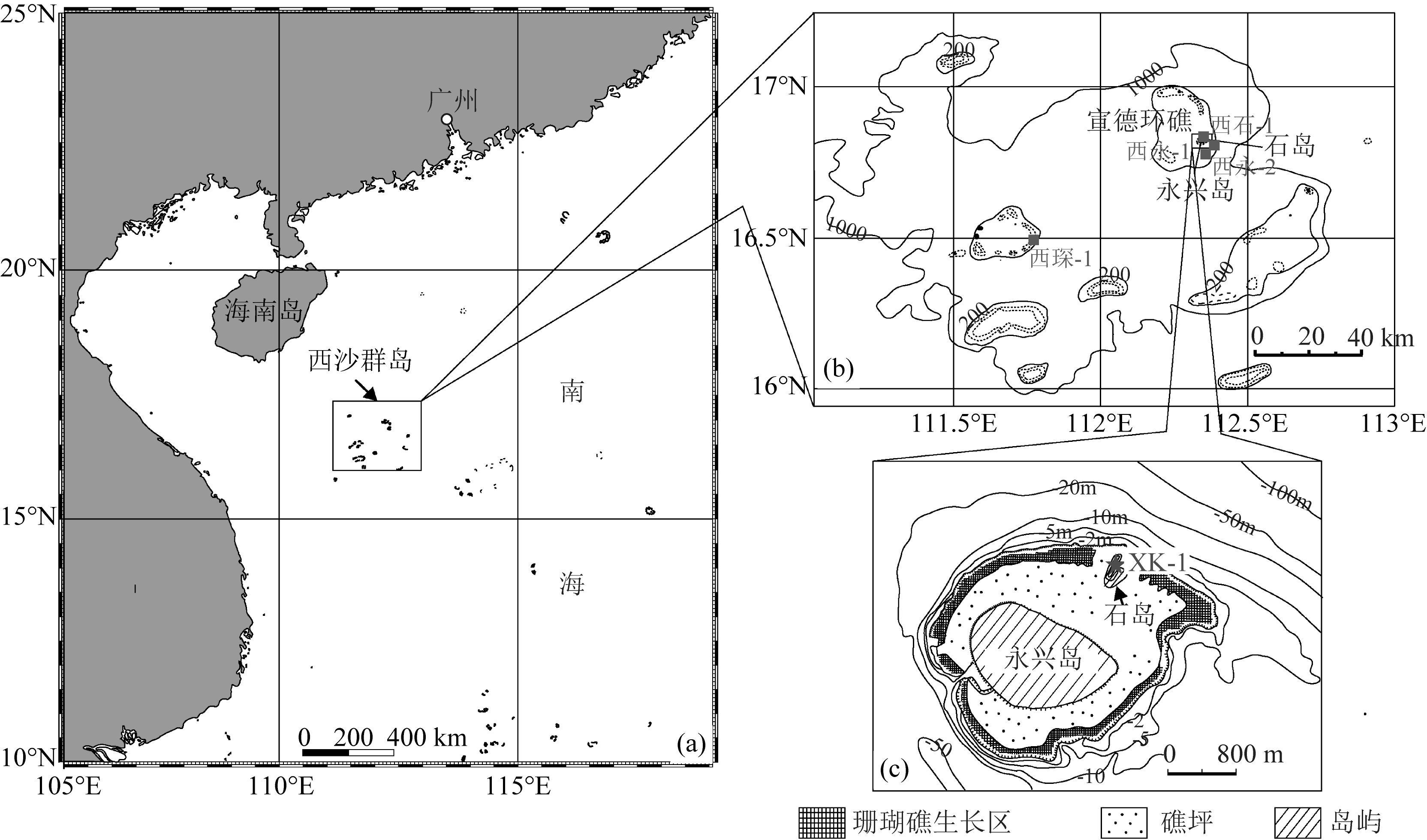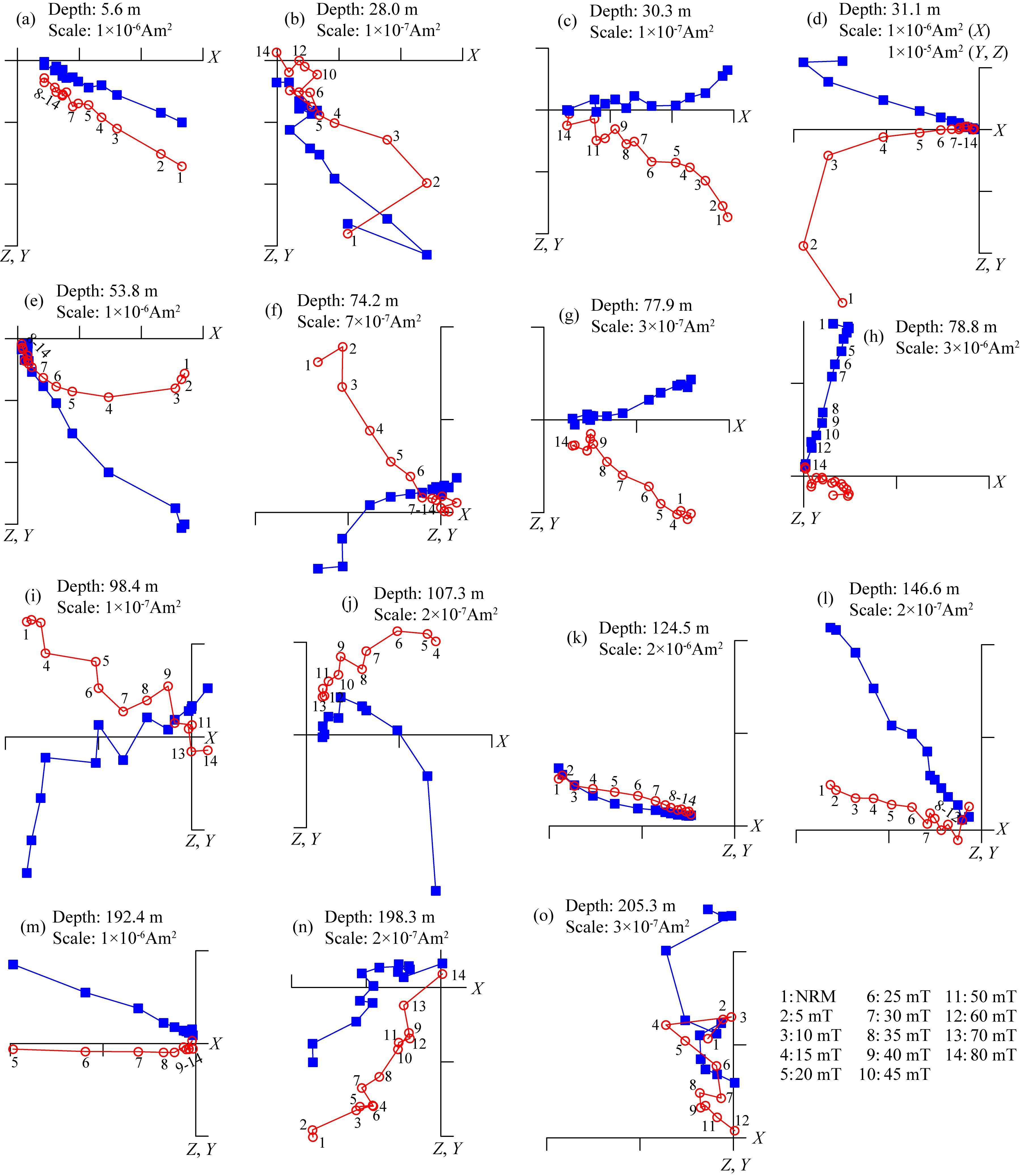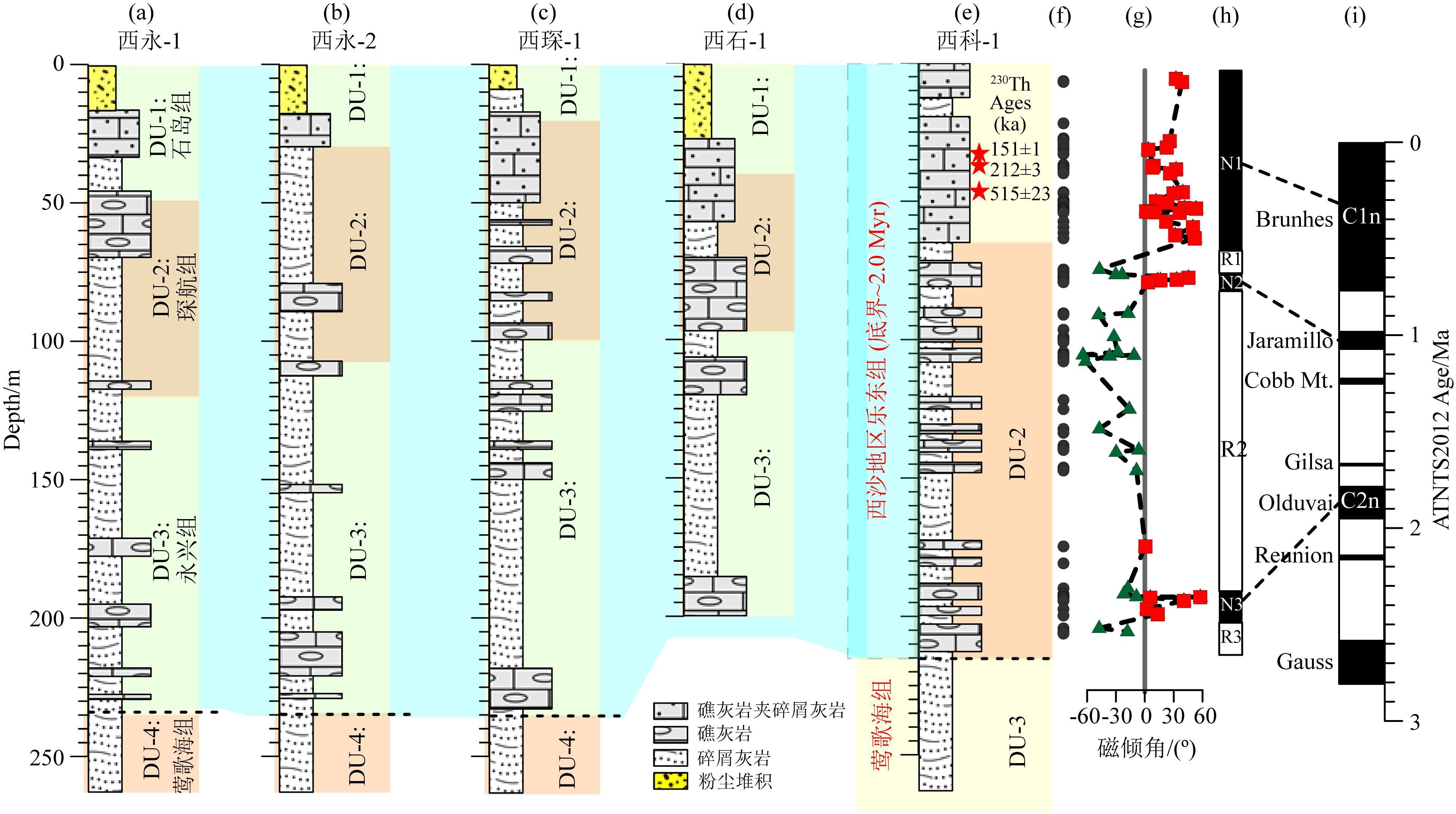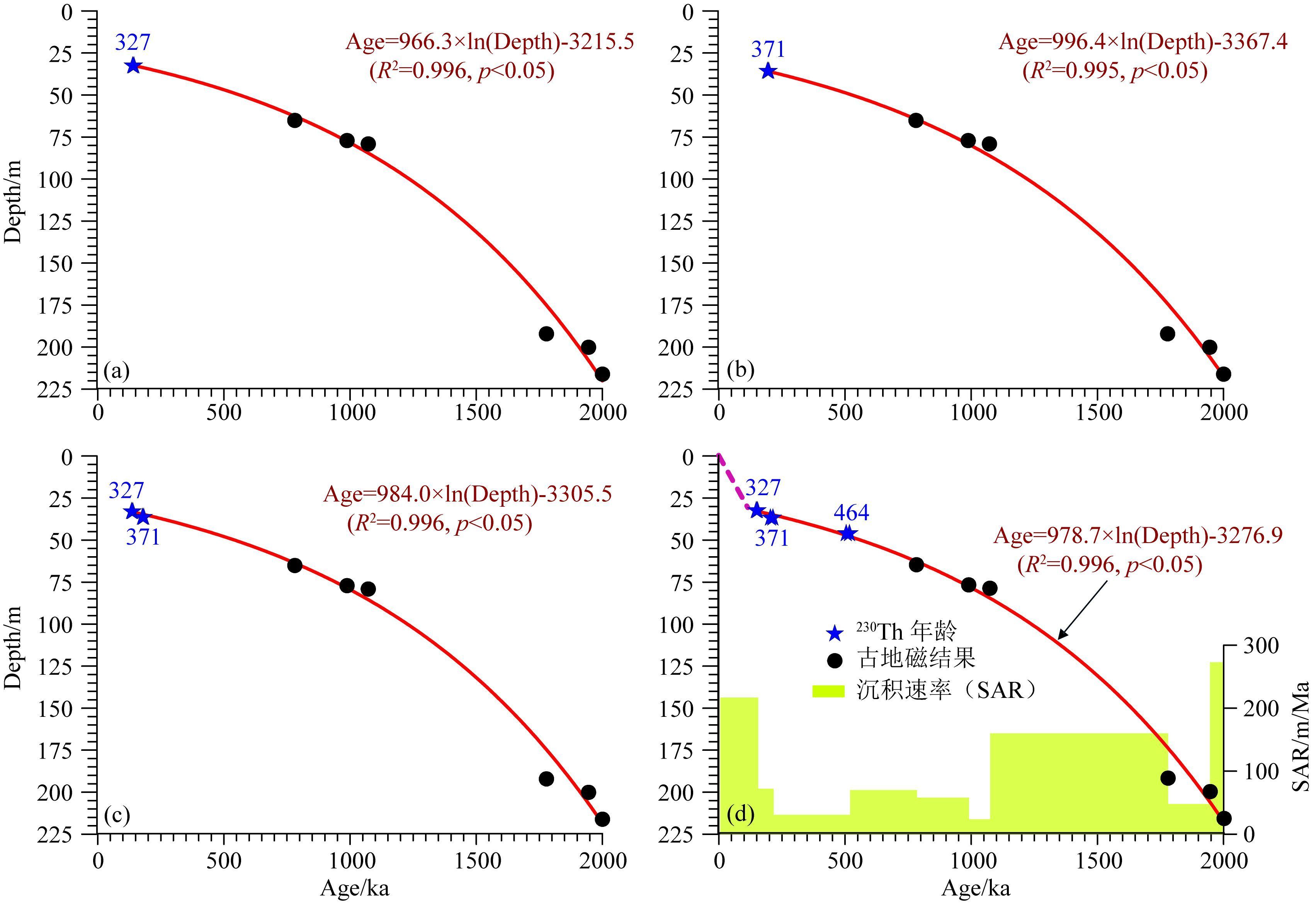2. 同济大学海洋与地球科学学院, 海洋地质国家重点实验室, 上海 200092;
3. 中国科学院地质与地球物理研究所, 岩石圈演化国家重点实验室, 北京 100029;
4. 中国科学院地球环境研究所, 黄土与第四纪地质国家重点实验室, 西安 710075;
5. 中国科学院南京地质与古生物研究所, 资源地层学与古地理学重点实验室, 南京 210008;
6. 西安交通大学, 全球环境变化研究院, 西安 710049;
7. 成都理工大学地球科学学院, 成都 610059;
8. 中国科学院深海科学与工程研究所, 海南三亚 572000;
9. 国家海洋局海口海洋环境监测中心站, 海口 570311;
10. 中国科学院大学, 北京 100049
2. State Key Laboratory of Marine Geology, Tongji University, Shanghai 200092, China;
3. State Key Laboratory of Lithospheric Evolution, Institute of Geology and Geophysics, Chinese Academy of Sciences, Beijing 100029, China;
4. State Key Laboratory of Loess and Quaternary Geology, Institute of Earth Environment, Chinese Academy of Sciences, Xi'an 710075, China;
5. Nanjing Institute of Geology and Palaeontology, Chinese Academy of Sciences, Nanjing 210008, China;
6. Institute of Global Environmental Change, Xi'an Jiaotong University, Xi'an 710049, China;
7. School of Geoscience, Chengdu University of Technology, Chengdu 610059, China;
8. Sanya Institute of Deep-sea Science and Engineering, Chinese Academy of Sciences, Sanya Hainan 572000, China;
9. Haikou Marine Environment Monitoring Central Station, State Oceanic Administration, Haikou 570311, China;
10. University of Chinese Academy of Sciences, Beijing 100049, China
作为亚洲最大的边缘海,南海的洋壳扩张主要发生于32~17 Ma (Tapponnier et al., 1982; Taylor and Hayes, 1983; Tamaki and Honza, 1991; Briais et al., 1993; Tsai et al., 2004; Li et al., 2014).与此同时,包括东沙、西沙和南沙在内的碳酸盐台地广泛发育(Wilson, 2002; Sattler et al., 2009).这些新近纪持续发育的碳酸盐沉积,不仅是重要的油气储藏资源,也是全球气候变化与碳循环的重要环节(Fulthorpe and Schlanger, 1989; Sun and Esteban, 1994; Wilson, 2002; Bachtel et al., 2004; Wang and Li, 2009).
为详细恢复碳酸盐台地的堆积历史,前人已在西沙和南沙群岛完成多支钻孔的钻探工作,包括西永-1(1251 m)、西永-2(600 m)、西石-1(200 m)、西琛-1(802 m)、南永-1(152 m)、南永-2(414 m) 等.基于这些钻孔的研究显示,南海南部的碳酸盐台地基底是古新世-早渐新世的断块(Fulthorpe and Schlanger, 1989; Sales et al., 1997; Williams, 1997; Hutchison, 2004; Hutchison and Vijayan, 2010),而北部则是古隆起或海底火山(Ma et al., 2011; Wu et al., 2014).基于碳酸盐沉积学的研究表明西沙和南沙的碳酸盐发育过程基本一致(张明书等, 1989; 赵焕庭等, 1992; 朱袁智等, 1997),但南部的起始时间应早于北部(丘燕和王英民, 2001; 魏喜等, 2005).在这些研究的基础上,恢复了造礁藻类生态系统由群落演替到群落取代的演化过程(许红等, 1999),分析了氧、碳同位素和微量元素地球化学特征及其与大气淡水成岩的关系(刘健等, 1998),并提出白云岩化过程是准同生成因(魏喜等, 2008).尽管这些研究在沉积、构造等方面为详细了解生物礁的发育过程及其在区域环境演化过程中的可能地位积累了大量非常有价值的证据与认识,但由于缺乏关键的年代学数据,南海新近纪生物礁长时间序列的演化过程与规律至今尚不清楚.因此,本文尝试利用古地磁和230Th定年方法,建立西沙群岛乐东组的年代学框架,并进而探讨第四纪以来生物礁发育的过程.
2 研究区及材料 2.1 西沙群岛西沙群岛大小共包括29个岛屿,总面积达1836 km2,其中以永兴岛最大(图 1).岛上生物繁盛,已发现38属127种造礁生物(邹仁林等, 1983; Nie et al., 1997).主要的构造背景是曾于中生代暴露、晚古近纪沉入海底的西沙古隆起(徐国强等, 2002; Fyhn et al., 2013);此后热带生物礁广泛发育,形成岛礁体系.

|
图 1 研究区地理位置(a)、西沙群岛(b)、西科1井(XK-1) 位置(c) Fig. 1 Schematic maps showing the study area (a), Xisha (Paracel) Islands (b) and drilling position (c). Solid lines in b and c indicate water depth, and dash lines in b indicate the modern reef edge |
XK-1孔位于西沙群岛东北缘的石岛上,由中海石油(中国) 有限公司负责钻探,2013年完成钻进取芯.全孔进尺1268 m,平均取芯率80%.上部215 m为乐东组地层(朱伟林等, 2015),可划分为上下两个岩性单元(图 2).其中,上部DU-1为礁灰岩,含生物碎屑灰岩;下部DU-2以礁灰岩与生物碎屑灰岩互层为主,底部为一层白云岩化层.下伏地层为莺歌海组(DU-3),与上覆乐东组呈不整合接触关系(朱伟林等, 2015).受岩心性状影响,莺歌海组未能取到足够的古地磁研究样品,本次研究主要针对215 m以浅的乐东组地层展开.

|
图 2 西科1井乐东组岩石地层单元与古地磁采样层位 TST, 海侵体系域; HST, 高位体系域(朱伟林等(2015)) Fig. 2 Lithostratigraphy, lithological units, depositional systems tract, sampling position for dating study of the XK-1 core |
岩石磁学测试包括等温剩磁(IRM)、磁滞回线和一阶反转曲线(FORC),利用中国科学院地质与地球物理研究所古地磁与年代学实验室的振动样品磁力仪(MicroMag 3900 VSM) 进行测试.磁滞回线和等温剩磁的最大外加磁场均为±1.0 T.典型样品的FORC曲线的最大外加场强为1.0 T,测量步长为3.2 mT,每条FORC由125条子曲线组成.测量原始数据由FORCinel version 1.17软件(Harrison and Feinberg, 2008) 进行计算.
3.2 系统退磁利用台钻从保存完整的岩心光滑表面定向钻取2 cm (直径)×2.5 cm (高) 的圆柱体,共获得90块定向样品.剩磁测量在中国科学院地质与地球物理研究所古地磁与年代学实验室进行.由于样品的天然剩磁强度多在10-9~10-10 Am2之间,已与2G-760型低温超导磁力仪的背景值(10-11 Am2) 接近,我们选用2G公司新一代低温超导自动磁力仪(2G-rapid) 进行剩磁测量.为去除黏滞剩磁影响,并获得特征剩磁方向,采用交变退磁方法,最高外加场强为80 mT,间距为5~10 mT,共13步.测量数据采用Randolph J. Enkin开发的PGMSC (V4.2) 数据处理软件,采用经原点的线性拟合方式(Kirschvink, 1980),每次拟合利用不少于5个连续数据点进行,且最大角偏差小于15°.
3.3 230Th定年根据矿物学分析结果(翟世奎等, 2015),从古地磁样品中挑选三个层位样品(32.7 m, 37.1 m, 46.4 m) 进行230Th定年分析.样品是在带有正压系统的操作台上通过直径为0.9 mm的牙钻采取的粉末样,样品量在100~200 mg左右,采样层厚为1~2 mm.由于古地磁样品具有定向特性,每一层位的样品均对顶、底两侧进行取样,以对结果进行交叉检验.所取样本在西安交通大学同位素实验室进行测试,分析仪器为Neptune型多接收器电感耦合等离子体质谱仪(MC-ICP-MS) (Cheng et al., 2013).
4 结果 4.1 载磁矿物 4.1.1 等温剩磁获得曲线从IRM获得曲线来看,其IRM0.3T/SIRM变化较小(0.95~0.99) 说明了沉积物的磁性矿物主要为低矫顽力矿物.通常来说,沉积物中的磁性矿物是多种成分的组合.研究者因此利用数学方法将具有不同矫顽力特征的矿物组分区分开来(Egli, 2003).这里,我们利用Matlab 7.1对IRM获得曲线进行矫顽力分解.可以看出,矫顽力谱为单峰-多峰分布,其主峰的矫顽力值为20~40 mT,次峰则位于40~90 mT之间(图 3).

|
图 3 IRM获得曲线及其反向场退磁曲线(a1-d1)、磁滞回线(e1-h1) 和矫顽力谱分析 Fig. 3 IRM acquisition curves (a1-d1), coercivity distribution for selected samples (a2-d2), hysteresis loops (e1-h1) along with the ΔM (e2-h2) and dΔM/dB (e3-h3) curves for selected samples from the XK-1 core. a and e, 37.3 m; b and f, 107.3 m; c and g, 145.5; d and h, 196.5 m. |
磁滞回线及其ΔM、dΔM/dB曲线可以进一步确认沉积物中磁性矿物的特征.结果表明:磁滞回线主要为超顺磁或准单畴型,指示磁性矿物主要为低矫顽力的磁性矿物.进一步分析ΔM、dΔM/dB曲线可以看出,大多数样品的矫顽力谱分析的主峰位于9~30 mT,同时存在一个30~60 mT的次峰(图 3).
4.1.3 一阶反转曲线FORC不但可以用来确定磁性矿物矫顽力的分布以及磁性矿物颗粒之间磁相互作用的强弱,而且还可以帮助区分磁性矿物的种类和磁畴状态(秦华峰等, 2008; Liu et al., 2015).结果显示,钻孔样品与现代沉积物样品的表现类似,矫顽力主要分布在5~40 mT之间,峰值位于10 mT左右;所有样品的FORC等值线均在纵轴上有所展布,说明样品中存在明显的静磁相互作用;等值线椭圆与纵轴相交(图 4).由于本次测试的生物礁沉积样本的磁化率值大多接近测量仪器的本底值,无法进一步开展其他的岩石磁学研究,因此,综合上述岩石磁学的结果,推测所测样品中的磁性矿物主要是低矫顽力的PSD颗粒的磁铁矿.

|
图 4 一阶反转曲线(FORC) (a) 37.3 m; (b) 107.3 m; (c) 145.5; (d) 196.5 m. Fig. 4 FORC diagrams for selected samples from the XK-1 core |
大部分样品表现为两种磁组分,通过20 mT交变磁步骤,基本消除了次生磁成分的影响.因此选用20~60 mT的区间剩磁分量,利用“最小二乘法拟合”方法(Kirschvink, 1980) 进行直线段拟合,最终获得了具有稳定特征剩磁的56块样品(约占总样品数的62%).代表性样品的退磁矢量投影图(亦称Z-氏图) (Zijderveld, 1967) 见图 5.这56块具有稳定剩磁特征样品的磁极性序列表现为6个磁极性区间,分别为:负极性R1(65~77 m)、R2(79~192 m) 和R3(200 m以深),正极性N1(0~65 m)、N2(77~79 m) 和N3(192~200 m).

|
图 5 系统退磁结果正交投影图 实心方框代表水平投影,空心圆代表垂直投影;NRM为天然剩磁. Fig. 5 Orthogonal projections of representative progressive alternating field demagnetization The solid (open) squares (circles) represent the horizontal (vertical) planes. NRM is the natural remanent magnetization.Note that the magnetic declinations are arbitrary. |
230Th定年结果列于表 1.XK-1孔已有的矿物学研究表明(翟世奎等, 2015),乐东组上部生物礁沉积中碳酸盐矿物以原生文石和高锰方解石为主.本次测试中,除了样品464中的铀含量偏低,所有完成测试的样品在年龄误差范围内从顶到底没有发生倒转,年龄变化顺序和采样位置顺序一致,说明生物礁沉积保持了较为封闭的体系,本次研究测得的年龄值可信.
|
|
表 1 铀-钍同位素与西科1井测年结果 Table 1 U-Th isotopic data and 230Th dates of the XK-1 core |
从岩石磁学结果来看,磁滞回线、等温剩磁获得曲线与一阶反转曲线结果均表明西沙群岛XK-1孔礁相沉积物的磁性矿物可能主要由低矫顽力的磁铁矿组成.从特征剩磁的数据分布来看,所有数据作为整体可用一元高斯方程予以拟合;同时,其数学期望(21.7°±6.3°, n=56) 与研究区的理论磁倾角(20.7°±0.3°)(http://www.ngdc.noaa.gov/geomag/[2016-05-25]) 十分接近.这些证据表明西科1井生物礁磁性地层的结果是可靠的.
因此,基于钻孔的沉积特征、古地磁结果、230Th年代,将上述获得的西科1井的磁极性序列与国际地磁极性年表(ATNTS2012, Hilgen et al., 2012) 进行对比:
(1) 由于乐东组上部地层(DU-1) 未见明显的间断面(朱伟林等, 2015),同时参考230Th定年结果,西科1井正极性区间N1应对应于布容正极性时(C1n).然而,由于岩心破碎的原因,63~65 m深度未能获得古地磁数据,参照岩性特征在65 m处可划分为DU-1和DU-2两个岩性区间,我们将正极性区间N1的底界设定于65 m,年龄为0.78 Ma.
(2) 类似地,由于乐东组DU-2区间内未发现明显的沉积间断面(朱伟林等, 2015),西科1井正极性区间N2顺序对比至加拉米洛正极性亚时(C1r.1n).由于80~90 m深度区间内以碎屑生物灰岩为主,我们将正极性区间N2 (77~79 m) 对应于C1r.1n,年龄为0.99~1.07 Ma.
(3) 西科1井首个主要的岩性界线位于215 m处(朱伟林等, 2015),而215~280 m内均未能获得有效古地磁样品,且特征剩磁在200 m以深倾角为负值.另一方面,超微化石结果(祝幼华, 未发表数据) 指示沉积单元DU-2底部可对比于超微化石带NN18,其年龄为2.0 Ma.基于以上证据与推测,我们将正极性区间N3(192~200 m) 对应于奥杜维尔正极性时(C2n),年龄为1.78~1.95 Ma.
在这一对比框架之下,西科1井负极性区间R1-R3可顺序对比至松山负极性时.
5.2 乐东组的年代学框架前人研究已指出(张明书等, 1989; Li et al., 2009),在沉积特征方面西沙群岛内部各钻孔及西沙与南沙群岛钻孔之间并未有实质差异.西沙群岛已钻进获取了永兴岛的西永-1孔(1251 m)、西永-2(600 m),石岛的西石-1(200 m),以及琛航岛的西琛-1(802 m).因采信于不同的划分标准,研究者给出了乐东组不同的底界位置与年龄.(1) 在西琛-1孔的研究中,孟祥营(1989)根据Globorotalia truncatulinoides和Gr. menardii两个特征种化石的初现面,将乐东组的底界定于210 m;张明书等(1989)依据岩石地层特征、何起祥和张明书(1990)依据白云岩化特征,将乐东组的底界定于218 m,韩春瑞(1989)、韩春瑞和孟祥营(1990)依据岩石地球化学变化将底界定于213 m;此外,张明书等(1996)曾依据古地磁研究的结果将180 m处定为乐东组底界.(2) 在西永-1孔的研究中,王崇友等(1979)依据岩石地层特征将乐东组底界定于150 m,此后张明书等(1989)重新研究了钻孔岩性变化特征,将乐东组底界更改为235 m,不过张明书等(1994)在依据生物礁沉积的磁化率变化的基础上,将乐东组的底界重新定于190 m,而吕炳全等(2002)根据岩性变化与重建的海平面变化认为乐东组的底界仅埋深22 m.(3) 在西永-2孔的研究中,孟祥营(1989)依据特征化石Globorotalia truncatulinoides的初现面,将乐东组底界定于235 m,张明书等(1989)依据岩性变化认为应划至256 m.在这些岩石地层单元划分的基础上,乐东组底界的年龄被特征化石限定于1.8~2.0 Ma,或直接对比与国际地层年表,定于1.8 Ma或2.6 Ma.
根据已有的研究成果可以看出,虽然前人针对西沙地区的生物礁沉积开展了大量工作,但由于年代学工作的不足和岩石地层单元划分的标准不一,乐东组底界不论是埋深还是年龄均未能达成较为一致的认识.因此,为了确定乐东组的底界与埋深,首先需要给出统一的岩石地层单元划分标准,再由此确定乐东组底界的埋深.
本研究中,根据岩石地层单元划分结果(朱伟林等, 2015),乐东组的底界位于第一主要暴露面,此界面之上存在较为明显的白云岩化特征.根据这一划分标准,西科1井乐东组底界位于215 m,可与构造上广泛解译出的T20界线(Wu et al., 2014) 比对.同时,根据张明书等(1989)四孔综合岩性对比方案,西永-1、西永-2、西琛-1和西石-1四孔在235 m处有类似的白云岩化的特征与暴露面的存在.因此,本文将这一深度作为西沙地区乐东组的底界(图 6).在此基础上,根据本文获得的磁性地层结果,我们将乐东组的底界年龄限定在~2.0 Ma.而对于乐东组内部的年代地层框架,本文认为由于仍缺少足够的绝对定年结果,仍需留待今后的工作中予以补充和完善.

|
图 6 西沙地区乐东组区域对比(a-d) 和西科1井230Th、磁性地层结果(e-h) Fig. 6 Lithostratigraphic correlation among the cores of Xiyong-1 (a), Xiyong-2 (b), Xichen-1 (c), Xishi-1 (d) and XK-1 with 230Th dating results (e). (f) Positions of paleomagnetic samples; (g) Inclinations of the ChRM; and (h) Magnetic polarity sequence of the XK-1 core; (i) The Astronomically Tuned Neogene Time Scale of Hilgen et al. (2012) (ATNTS2012). Dashed lines between h and i show possible correlations of the recognized magnetozones to the ATNTS 2012 |
综合西科1井乐东组230Th测年与古地磁结果,乐东组生物礁沉积可以根据沉积速率变化划分为三个时期:(1) 2.0~1.1 Ma,290~160 m/Ma;(2) 1.1~0.15 Ma,24~72 m/Ma;(3) 0.15 Ma以来,217m/Ma.进一步的时-深关系分析显示,所有年龄控制点可由一元对数函数予以拟合(图 7),指示了230Th测年与磁性地层结果具有很好的一致性.

|
图 7 西科1井乐东组时-深关系分析 Fig. 7 Age-depth model which was fit by a logarithmic function to test the reliability of 230Th ages (a-d) and sediment accumulation rate (SAR) changes (d) of the XK-1 core during the past 2.0 Ma |
前人已对生物礁的发育机制开展了大量研究,其中构造(Pigram et al., 1989; Wilson et al., 1999, 2000; Bosence, 2005; Hutchison and Vijayan, 2010; Wu et al., 2014)、海平面变化(Belopolsky and Droxler, 2003, 2004)、洋流状况(Betzler et al., 2009; Lüdmann et al., 2012, 2013) 及其他一些因素(Ma et al., 2015) 被认为是生物礁发育的主要控制因素.根据本文的结果,由于乐东组的时-深关系可以由一元函数予以拟合,指示了在轨道-构造时间尺度上,西沙地区第四纪以来生物礁的生长发育过程主要受到了区域构造沉降这一单因素的控制.不过由于本研究所获得年龄控制点相对两千万年的时间跨度仍十分有限,进一步辨析不同因素对生物礁发育的影响需今后更多资料的积累.
| Bachtel S L, Kissling R D, Martono D, et al. 2004. Seismic stratigraphic evolution of the Miocene-Pliocene Segitiga Platform, East Natuna Sea, Indonesia:the origin, growth, and demise of an isolated carbonate platform.//Eberli G P, Massaferro J L, Sarg J F. Seismic Imaging of Carbonate Reservoirs and Systems. AAPG Memoir, Tulsa, 309-328. | |
| Belopolsky A V, Droxler A W. 2003. Imaging Tertiary carbonate system-The Maldives, Indian Ocean:insights into carbonate sequence interpretation. The Leading Edge, 22(7): 646-652. DOI:10.1190/1.1599690 | |
| Belopolsky A V, Droxler A W. 2004. Seismic expressions of prograding carbonate bank margins:middle Miocene, Maldives, Indian Ocean.//Eberli G P, Massaferro J L, Sarg J F. Seismic Imaging of Carbonate Reservoir and Systems. AAPG Memoir, Tulsa, 267-290. | |
| Betzler C, Hübscher C, Lindhorst S, et al. 2009. Monsoon-induced partial carbonate platform drowning (Maldives, Indian Ocean). Geology, 37(10): 867-870. DOI:10.1130/G25702A.1 | |
| Bosence D. 2005. A genetic classification of carbonate platforms based on their basinal and tectonic settings in the Cenozoic. Sedimentary Geology, 175(1-4): 49-72. DOI:10.1016/j.sedgeo.2004.12.030 | |
| Briais A, Patriat P, Tapponnier P. 1993. Updated interpretation of magnetic anomalies and seafloor spreading stages in the South China Sea:Implications for the Tertiary tectonics of Southeast Asia. Journal of Geophysical Research:Solid Earth, 98(B4): 6299-6328. DOI:10.1029/92JB02280 | |
| Cheng H, Edwards R L, Shen C C, et al. 2013. Improvements in 230Th dating, 230Th and 234U half-life values, and U-Th isotopic measurements by multi-collector inductively coupled plasma mass spectrometry. Earth and Planetary Science Letters, 371-372: 82-91. DOI:10.1016/j.epsl.2013.04.006 | |
| Egli R. 2003. Analysis of the field dependence of remanent magnetization curves. Journal of Geophysical Research:Solid Earth, 108: 2081. | |
| Fulthorpe C S, Schlanger S O. 1989. Paleo-oceanographic and tectonic settings of Early Miocene reefs and associated carbonates of offshore Southeast Asia. AAPG Bulletin, 73(6): 729-756. | |
| Fyhn M B W, Boldreel L O, Nielsen L H, et al. 2013. Carbonate platform growth and demise offshore Central Vietnam:Effects of Early Miocene transgression and subsequent onshore uplift. Journal of Asian Earth Sciences, 76: 152-168. DOI:10.1016/j.jseaes.2013.02.023 | |
| Han C R, Meng X Y. 1990. Foraminiferal fauna distribution in reef-facies beds since late Miocene in Xisha Islands and its significance. Marine Geology & Quaternary Geology, 10(2): 65-80. | |
| Han C R. 1989. Reef carbonate mineral and oxygen and carbon stable isotope characteristics of Xichen-1-Well. Marine Geology & Quaternary Geology, 9(4): 29-40. | |
| Harrison R J, Feinberg J M. 2008. FORCinel:An improved algorithm for calculating first-order reversal curve distributions using locally weighted regression smoothing. Geochemistry, Geophysics, Geosystems, 9: Q05016. | |
| He Q X, Zhang M S. 1990. Origin of Neogene dolomites in Xisha Islands and their significance. Marine Geology & Quaternary Geology, 10(2): 45-55. | |
| Hilgen F J, Lourens L J, Van Dam J A. 2012. The Neogene period.//Gradstein F M, Ogg J G, Schmitz M D, et al. The Geologic Time Scale. Oxford:Elsevier, 923-978. | |
| Hutchison C S, Vijayan V R. 2010. What are the Spratly Islands?. Journal of Asian Earth Sciences, 39(5): 371-385. DOI:10.1016/j.jseaes.2010.04.013 | |
| Hutchison C S. 2004. Marginal basin evolution:the southern South China Sea. Marine and Petroleum Geology, 21(9): 1129-1148. DOI:10.1016/j.marpetgeo.2004.07.002 | |
| Jaffey A H, Flynn K F, Glendenin L E, et al. 1971. Precision Measurement of Half-Lives and Specific Activities of 235U and 238U. Physical Review C, 4: 1889-1906. DOI:10.1103/PhysRevC.4.1889 | |
| Kirschvink J L. 1980. The least-squares line and plane and the analysis of palaeomagnetic data. Geophysical Journal International, 62(3): 699-718. DOI:10.1111/gji.1980.62.issue-3 | |
| Li C F, Xu X, Lin J, et al. 2014. Ages and magnetic structures of the South China Sea constrained by deep tow magnetic surveys and IODP Expedition 349. Geochemistry, Geophysics, Geosystems, 15(12): 4958-4983. DOI:10.1002/2014GC005567 | |
| Li Q Y, Zhong G F, Tian J. 2009. Stratigraphy and sea level changes.//Wang P X, Li Q Y. The South China Sea:Paleoceanography and Sedimentology. Netherlands:Springer, 75-170. | |
| Liu J, Han C R, Wu J Z, et al. 1998. Geochemical evidence for the meteoric diagenesis in Pleistocene reef limestones of Xisha Islands. Acta Sedimentologica Sinica, 16(4): 71-77. | |
| Liu S Z, Deng C L, Xiao J L, et al. 2015. Insolation driven biomagnetic response to the Holocene Warm Period in semi-arid East Asia. Scientific Reports, 5: 8001. DOI:10.1038/srep08001 | |
| Lüdmann T, Kalvelage C, Betzler C, et al. 2013. The Maldives, a giant isolated carbonate platform dominated by bottom currents. Marine and Petroleum Geology, 43: 326-340. DOI:10.1016/j.marpetgeo.2013.01.004 | |
| Lüdmann T, Wiggershaus S, Betzler C, et al. 2012. Southwest Mallorca Island:A cool-water carbonate margin dominated by drift deposition associated with giant mass wasting. Marine Geology, 307-310: 73-87. DOI:10.1016/j.margeo.2011.09.008 | |
| Lü B Q, Xu G Q, Wang H G, et al. 2002. Sea floor spreading recorded by drowning events of Cenozoic carbonate platforms in the Souht China Sea. Chinese Journal of Geology, 37(4): 405-414. | |
| Ma B J, Wu S G, Sun Q L, et al. 2015. The late Cenozoic deep-water channel system in the Baiyun Sag, Pearl River Mouth Basin:Development and tectonic effects. Deep Sea Research Part II:Topical Studies in Oceanography, 122: 226-239. DOI:10.1016/j.dsr2.2015.06.015 | |
| Ma Y B, Wu S G, Lü F L, et al. 2011. Seismic characteristics and development of the Xisha carbonate platforms, northern margin of the South China Sea. Journal of Asian Earth Sciences, 40(3): 770-783. DOI:10.1016/j.jseaes.2010.11.003 | |
| Meng X Y. 1989. Biostratigraphical boundaries and environmental changes of the Xisha Islands (Paracel Islands) since late Miocene shown by foraminiferal fauna. Acta Micropalaeontology Sinica, 6(4): 345-356. | |
| Nie B F, Chen T G, Liang M T, et al. 1997. Relationship between coral growth rate and sea surface temperature in the northern part of South China Sea during the past 100 a. Science in China Series D:Earth Sciences, 40(2): 173-182. DOI:10.1007/BF02878376 | |
| Pigram C J, Davies P J, Feary D A, et al. 1989. Tectonic controls on carbonate platform evolution in southern Papua New Guinea:passive margin to foreland basin. Geology, 17(3): 199-202. DOI:10.1130/0091-7613(1989)017<0199:TCOCPE>2.3.CO;2 | |
| Qin H F, Liu Q S, Pan Y X. 2008. The first-order reversal curve (FORC) diagram:Theory and case study. Chinese J. Geophys. (Chinese Edition), 51(3): 743-751. | |
| Qiu Y, Wang Y M. 2001. Reefs and paleostructure and paleoenvironment in the South China Sea. Marine Geology & Quaternary Geology, 21(1): 65-73. | |
| Sales A O, Jacobsen E C, Morado A A Jr, et al. 1997. The petroleum potential of deep-water northwest Palawan Block GSEC 66. Journal of Asian Earth Sciences, 15(2-3): 217-240. | |
| Sattler U, Immenhauser A, Schlager W, et al. 2009. Drowning history of a Miocene carbonate platform (Zhujiang Formation, South China Sea). Sedimentary Geology, 219(1-4): 318-331. DOI:10.1016/j.sedgeo.2009.06.001 | |
| Sun S Q, Esteban M. 1994. Paleoclimatic controls on sedimentation, diagenesis, and reservoir quality:lessons from Miocene carbonates. AAPG Bulletin, 78(4): 519-543. | |
| Tamaki K, Honza E. 1991. Global tectonics and formation of marginal basins:Role of the western Pacific. Episodes, 14(3): 224-230. | |
| Tapponnier P, Peltzer G, Le Dain A Y, et al. 1982. Propagating extrusion tectonics in Asia:New insights from simple experiments with plasticine. Geology, 10(12): 611-616. DOI:10.1130/0091-7613(1982)10<611:PETIAN>2.0.CO;2 | |
| Taylor B, Hayes D E. 1983. Origin and history of the South China Sea Basin.//Hayes D E. The Tectonic and Geologic Evolution of Southeast Asian Seas and Islands. New York, US:American Geophysical Union, 89-104. | |
| Tsai C H, Hsu S K, Yeh Y C, et al. 2004. Crustal thinning of the Northern Continental Margin of the South China Sea. Marine Geophysical Researches, 25(1-2): 63-78. DOI:10.1007/s11001-005-0733-5 | |
| Wang C Y, He X X, Qiu S Y. 1979. Preliminary study about carbonate strata and micropaleontology of well Xiyong-1 in The Xisha Islands (Paracel Islands). Petroleum Geology and Experiment, 1(5): 23-32. | |
| Wang P X, Li Q Y. The South China Sea:Paleoceanography and Sedimentology.Netherlands: Springer, 2009. | |
| Wei X, Deng J F, Xie W Y, et al. 2005. Constraints on biogenetic reef formation during evolution of the South China Sea and exploration potential analysis. Earth Geoscience Frontiers, 12(3): 245-252. | |
| Wei X, Jia C Z, Meng W G. 2008. Dolomitization characteristics of carbonate rock in Xisha Islands and its formation:A case study of Well Xichen-1. Journal of Jilin University (Earth Science Edition), 39(2): 217-224. | |
| Williams H H. 1997. Play concepts-northwest Palawan, Philippines. Journal of Asian Earth Sciences, 15(2-3): 251-273. DOI:10.1016/S0743-9547(97)00011-1 | |
| Wilson M E J, Bosence D W J, Limbong A. 2000. Tertiary syntectonic carbonate platform development in Indonesia. Sedimentology, 47(2): 395-419. | |
| Wilson M E J, Chambers J L C, Evans M J, et al. 1999. Cenozoic carbonates in Borneo:case studies from northeast Kalimantan. Journal of Asian Earth Sciences, 17(1-2): 183-201. DOI:10.1016/S0743-9547(98)00045-2 | |
| Wilson M E J. 2002. Cenozoic carbonates in Southeast Asia:implications for equatorial carbonate development. Sedimentary Geology, 147(3-4): 295-428. DOI:10.1016/S0037-0738(01)00228-7 | |
| Wu S G, Yang Z, Wang D W, et al. 2014. Architecture, development and geological control of the Xisha carbonate platforms, northwestern South China Sea. Marine Geology, 350: 71-83. DOI:10.1016/j.margeo.2013.12.016 | |
| Xu G Q, Lü B Q, Wang H G. 2002. Drown event research:insight from Cenozoic carbonate platform in northern South China Sea. Journal of Tongji University (Natural Sciences), 30(1): 35-40. | |
| Xu H, Cai F, Wang Y J, et al. 1999. Miocene evolution of biogenic reefs and the role of reef algae in Xisha Islands. Chinese Science Bulletin, 44(13): 1435-1439. | |
| Zhai S K, Mi L J, Shen X, et al. 2015. Mineral compositions and their environmental implications in reef of Shidao Island, Xisha. Journal of China University of Geosciences, 40(4): 597-605. DOI:10.3799/dqkx.2015.047 | |
| Zhang M S, He Q X, Ye Z J. The Geologic Research of Deposition of Bioherm Carbonate in the Xisha Islands.Beijing: Science Press, 1989. | |
| Zhang M S, Liu J, Zhou M Q. 1994. Magnetic susceptibility of reef sequence of Xiyong-1-Well. Chinese Science Bulletin, 39(4): 340-343. | |
| Zhang M S, Zhou M Q, Liu J. 1996. Magnetostratigraphic study of Xisha reef sequence. Marine Geology & Quaternary Geology, 16(3): 61-65. | |
| Zhao H T, Sha Q A, Zhu Y Z. Quaternary Coral Reef:Geology of Yongshu Reef, Nansha Islands.Beijing: China Ocean Press, 1992. | |
| Zhu W L, Wang Z F, Mi L J, et al. 2015. Sequence stratigraphic framework and reef growth unit of Well Xike-1 from Xisha Islands, South China Sea. Journal of China University of Geosciences, 40(4): 677-687. DOI:10.3799/dqkx.2015.055 | |
| Zhu Y Z, Sha Q A, Guo L F, et al. Cenozoic Coral Reef Geology of Yongshu Reef, Nansha Islands.Beijing: Science Press, 1997. | |
| Zijderveld J D A. 1967. AD demagnetization of rocks:analysis of results.//Collinson D W, Creer K M, Runco S K, eds. Methods in Paleomagnetism. New York:Elsevier, 254-286. | |
| Zou R L, Meng Z M, Guan X L. 1983. Ecological analysis of ahermatypic corals from the northern shelf of South China Sea. Tropical Oceanology, 2(3): 238-243. | |
| 韩春瑞, 孟祥营. 1990. 西沙晚中新世以来礁相地层中有孔虫动物群的分布及其意义. 海洋地质与第四纪地质, 10(2): 65–80. | |
| 韩春瑞. 1989. 西琛一井礁相沉积碳酸盐矿物及氧、碳稳定同位素特征. 海洋地质与第四纪地质, 9(4): 29–40. | |
| 何起祥, 张明书. 1990. 西沙群岛新第三纪白云岩的成因与意义. 海洋地质与第四纪地质, 10(2): 45–55. | |
| 刘健, 韩春瑞, 吴建政, 等. 1998. 西沙更新世礁灰岩大气淡水成岩的地球化学证据. 沉积学报, 16(4): 71–77. | |
| 吕炳全, 徐国强, 王红罡, 等. 2002. 南海新生代碳酸盐台地淹没事件记录的海底扩张. 地质科学, 37(4): 405–414. | |
| 孟祥营. 1989. 西沙群岛晚中新世以来有孔虫生物地层界限及古环境变化. 微体古生物学报, 6(4): 345–356. | |
| 秦华峰, 刘青松, 潘永信. 2008. 一阶反转曲线(FORC) 图的原理及应用实例. 地球物理学报, 51(3): 743–751. | |
| 丘燕, 王英民. 2001. 南海第三纪生物礁分布与古构造和古环境. 海洋地质与第四纪地质, 21(1): 65–73. | |
| 王崇友, 何希贤, 裘松余. 1979. 西沙群岛西永一井碳酸盐岩地层与微体古生物的初步研究. 石油实验地质, 1(5): 23–32. | |
| 魏喜, 邓晋福, 谢文彦, 等. 2005. 南海盆地演化对生物礁的控制及礁油气藏勘探潜力分析. 地学前缘, 12(3): 245–252. | |
| 魏喜, 贾承造, 孟卫工. 2008. 西沙群岛西琛1井碳酸盐岩白云石化特征及成因机制. 吉林大学学报(地球科学版), 38(2): 217–224. | |
| 徐国强, 吕炳全, 王红罡. 2002. 新生代南海北部碳酸盐岩台地的淹没事件研究. 同济大学学报(自然科学版), 30(1): 35–40. | |
| 许红, 蔡峰, 王玉净, 等. 1999. 西沙中新世生物礁演化与藻类的造礁作用. 科学通报, 44(13): 1435–1439. | |
| 翟世奎, 米立军, 沈星, 等. 2015. 西沙石岛生物礁的矿物组成及其环境指示意义. 地球科学-中国地质大学学报, 40(4): 597–605. | |
| 张明书, 何起祥, 业治铮. 西沙生物礁碳酸盐沉积地质学研究.北京: 科学出版社, 1989. | |
| 张明书, 刘健, 周墨清. 1994. 西永一井礁序列的磁化率研究. 科学通报, 39(4): 340–343. | |
| 张明书, 周墨清, 刘健. 1996. 西沙礁序列的磁性地层学研究. 海洋地质与第四纪地质, 16(3): 61–65. | |
| 赵焕庭, 沙庆安, 朱袁智. 南沙群岛永暑礁第四纪珊瑚礁地质.北京: 中国海洋出版社, 1992. | |
| 朱伟林, 王振峰, 米立军, 等. 2015. 南海西沙西科1井层序地层格架与礁生长单元特征. 地球科学-中国地质大学学报, 40(4): 677–687. | |
| 朱袁智, 沙庆安, 郭丽芬, 等. 南沙群岛永暑礁新生代珊瑚礁地质.北京: 科学出版社, 1997. | |
| 邹仁林, 蒙致民, 关锡廉. 1983. 南海北部大陆架深水石珊瑚的生态分析. 热带海洋, 2(3): 238–243. | |
 2017, Vol. 60
2017, Vol. 60


